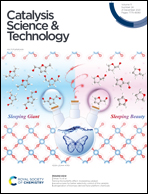Direct Z-scheme hierarchical heterostructures of oxygen-doped g-C3N4/In2S3 with efficient photocatalytic Cr(vi) reduction activity†
Abstract
O-doped g-C3N4/In2S3 hierarchical heterostructures with a direct Z-scheme mechanism were devised and constructed simply via loading In2S3 nanoflakes on the surface of O-doped g-C3N4 (OCN) hierarchical structures, in situ, employing pre-obtained OCN (prepared by condensation of oxalic acid and urea) and indium(III) dimethyldithiocarbamate (In(dedc)3) as precursors. Analyses of the energy band structure, density functional theory (DFT) computations and DMPO-ESR spin-trapping experiments demonstrate that the formation of a perfect heterointerface with a staggered alignment of band edges between OCN and In2S3 (IS), owing to their close contact, enables photoexcited carriers to migrate via a Z-scheme route, which can maintain the higher reduction and oxidation capability of electrons and holes, respectively. Furthermore, the Z-scheme OCN/IS heterostructures efficaciously facilitate the separation of photogenerated electrons and holes, as demonstrated using PL spectra, transient photocurrent densities and electrochemical impedance spectra (EIS). These lead to the enhanced photocatalytic activity towards reducing Cr(VI) into Cr(III). Besides, the integration of OCN with IS can enhance the responsiveness to visible light based on the results of UV-vis DRS, thereby inducing the formation of more electrons and holes,and also contributing to the improvement of the photocatalytic activity for Cr(VI) reduction. In consequence, all the pre-prepared OCN/IS hybrids possess markedly improved photocatalytic activities for Cr(VI) reduction, relative to pure OCN and pristine IS under visible light (λ > 420 nm) illumination. With the increase in the In(dedc)3 to OCN mass ratio (R), the photocatalytic activities of these OCN/IS hybrids increase first and then decrease. The sample with an optimum R of 0.9 (OCN/IS-0.9) can remove nearly 100% of Cr(VI) after 40 min of illumination, being superior to most of g-C3N4-based and IS-based photocatalysts. Its reaction rate constant for Cr(VI) photoreduction (0.08947 min−1) is 56.7 fold and 8.8 fold higher than that of pure OCN (0.00155 min−1) and pristine IS (0.00913 min−1), respectively. This work affords a deep understanding on designing preeminent Z-scheme photocatalysts towards the degradation of Cr(VI) under visible-light irradiation.



 Please wait while we load your content...
Please wait while we load your content...